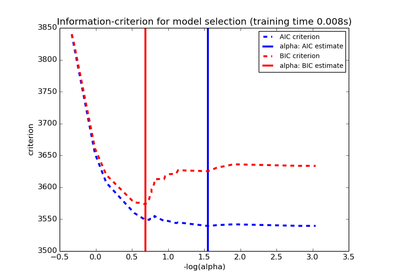3.2.3.2.1. sklearn.linear_model.LassoLarsIC¶
- class sklearn.linear_model.LassoLarsIC(criterion='aic', fit_intercept=True, verbose=False, normalize=True, precompute='auto', max_iter=500, eps=2.2204460492503131e-16, copy_X=True)¶
Lasso model fit with Lars using BIC or AIC for model selection
The optimization objective for Lasso is:
(1 / (2 * n_samples)) * ||y - Xw||^2_2 + alpha * ||w||_1
AIC is the Akaike information criterion and BIC is the Bayes Information criterion. Such criteria are useful to select the value of the regularization parameter by making a trade-off between the goodness of fit and the complexity of the model. A good model should explain well the data while being simple.
Parameters: criterion: ‘bic’ | ‘aic’ :
The type of criterion to use.
fit_intercept : boolean
whether to calculate the intercept for this model. If set to false, no intercept will be used in calculations (e.g. data is expected to be already centered).
verbose : boolean or integer, optional
Sets the verbosity amount
normalize : boolean, optional, default False
If True, the regressors X will be normalized before regression.
copy_X : boolean, optional, default True
If True, X will be copied; else, it may be overwritten.
precompute : True | False | ‘auto’ | array-like
Whether to use a precomputed Gram matrix to speed up calculations. If set to 'auto' let us decide. The Gram matrix can also be passed as argument.
max_iter: integer, optional :
Maximum number of iterations to perform. Can be used for early stopping.
eps: float, optional :
The machine-precision regularization in the computation of the Cholesky diagonal factors. Increase this for very ill-conditioned systems. Unlike the tol parameter in some iterative optimization-based algorithms, this parameter does not control the tolerance of the optimization.
Attributes: ``coef_`` : array, shape (n_features,)
parameter vector (w in the formulation formula)
``intercept_`` : float
independent term in decision function.
``alpha_`` : float
the alpha parameter chosen by the information criterion
See also
Notes
The estimation of the number of degrees of freedom is given by:
“On the degrees of freedom of the lasso” Hui Zou, Trevor Hastie, and Robert Tibshirani Ann. Statist. Volume 35, Number 5 (2007), 2173-2192.
http://en.wikipedia.org/wiki/Akaike_information_criterion http://en.wikipedia.org/wiki/Bayesian_information_criterion
Examples
>>> from sklearn import linear_model >>> clf = linear_model.LassoLarsIC(criterion='bic') >>> clf.fit([[-1, 1], [0, 0], [1, 1]], [-1.1111, 0, -1.1111]) ... LassoLarsIC(copy_X=True, criterion='bic', eps=..., fit_intercept=True, max_iter=500, normalize=True, precompute='auto', verbose=False) >>> print(clf.coef_) [ 0. -1.11...]
Methods
decision_function(X) Decision function of the linear model. fit(X, y[, copy_X]) Fit the model using X, y as training data. get_params([deep]) Get parameters for this estimator. predict(X) Predict using the linear model score(X, y[, sample_weight]) Returns the coefficient of determination R^2 of the prediction. set_params(**params) Set the parameters of this estimator. - __init__(criterion='aic', fit_intercept=True, verbose=False, normalize=True, precompute='auto', max_iter=500, eps=2.2204460492503131e-16, copy_X=True)¶
- decision_function(X)¶
Decision function of the linear model.
Parameters: X : {array-like, sparse matrix}, shape = (n_samples, n_features)
Samples.
Returns: C : array, shape = (n_samples,)
Returns predicted values.
- fit(X, y, copy_X=True)¶
Fit the model using X, y as training data.
Parameters: x : array-like, shape (n_samples, n_features)
training data.
y : array-like, shape (n_samples,)
target values.
Returns: self : object
returns an instance of self.
- get_params(deep=True)¶
Get parameters for this estimator.
Parameters: deep: boolean, optional :
If True, will return the parameters for this estimator and contained subobjects that are estimators.
Returns: params : mapping of string to any
Parameter names mapped to their values.
- predict(X)¶
Predict using the linear model
Parameters: X : {array-like, sparse matrix}, shape = (n_samples, n_features)
Samples.
Returns: C : array, shape = (n_samples,)
Returns predicted values.
- score(X, y, sample_weight=None)¶
Returns the coefficient of determination R^2 of the prediction.
The coefficient R^2 is defined as (1 - u/v), where u is the regression sum of squares ((y_true - y_pred) ** 2).sum() and v is the residual sum of squares ((y_true - y_true.mean()) ** 2).sum(). Best possible score is 1.0, lower values are worse.
Parameters: X : array-like, shape = (n_samples, n_features)
Test samples.
y : array-like, shape = (n_samples,)
True values for X.
sample_weight : array-like, shape = [n_samples], optional
Sample weights.
Returns: score : float
R^2 of self.predict(X) wrt. y.
- set_params(**params)¶
Set the parameters of this estimator.
The method works on simple estimators as well as on nested objects (such as pipelines). The former have parameters of the form <component>__<parameter> so that it’s possible to update each component of a nested object.
Returns: self :


